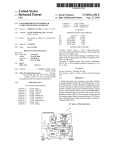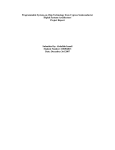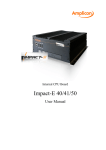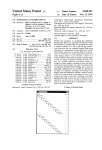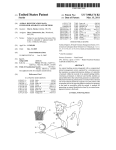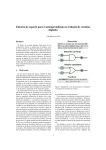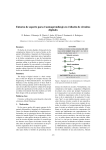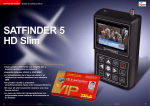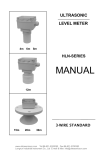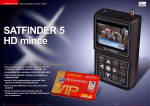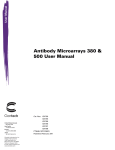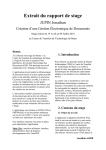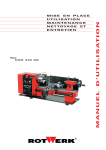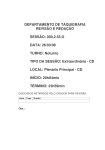Download /-l 403 /_l 404
Transcript
US007823127B2
(12) United States Patent
(10) Patent No.:
Zeidman
(54)
(45) Date of Patent:
DETECTING PLAGIARISM IN COMPUTER
SOURCE CODE
_
(75)
Inventor'
US 7,823,127 B2
.
Oct. 26, 2010
OTHER PUBLICATIONS
Paul Heckel, “A Technique for Isolating Differences Between Files”,
.
1978, Communications ofACM, vol. 21, Issue 4, pp. 264-268.*
Robert Marc Zeldman’ cupernno’ CA
J Howard Johnson, “Substring Matching for Clone Detection and
(Us)
Change Tracking”, 1994, Software Engineering Laboratory,
_
_
_
National Research Council of Canada.*
(73) Asslgnee: software Analysls and Forgnslc
Baker, “On ?nding Duplication and Near Duplication in Large Soft
Engllleerlllg Corn, Cupertlno, CA (Us)
ware Systems”, 1995, Reverse Engineering, 1995*
Subject to any disclaimer, the term of this
patent is extended or adjusted under 35
U_S_C_ 1540;) by 0 days
puter program and other texts”, 1996, SIGCSE ’96.*
Joy et al. “Plagiarism in Programming Assignments” , 1999, IEEE
Transactions on Education, vol. 42, No. 2, pp. 129-133.*
Michael Wise, “YAP3: improved detection of similarities in com
(*)
Notice:
Marcus et al. “Identi?cation of High-Level Concept Clones in Source
21
(
)
A 1_ N _: 12/330 492
pp
0
’
~
(22)
Code”, 2001, Automated Software Engineering, (ASE 2001).*
Lucca et al. “An Approach to Identify Duplicated Web Pages”, 2002,
.
COMPSAC 2002*
F?ed'
Dec‘ 8’ 2008
.
(65)
Hart et al. “Sherlock User Manual”, Nov. 2002, retrieved from:
.
.
http://web.archive.org/web/20030510140152/http://www.dcs.
Pnor Pubhcatlon Data
Us 2009/0089754 A1
warwick.ac.uldboss/manuals/sherlock.html.*
Apr' 2’ 2009
IPike/7t
“Sllllerloclg/ Plagiarism Detector”,/l2002/,/ retrieved frgm:
ttp: we .arc ive.or we 20020804114150 ttp: www.cs.usy .
Related US. Application Data
edu'au/"scilec?sherlocld'*
(63) Continuation-in-part of application No. 10/720,636,
?led on Nov. 25, 2003, now Pat. No. 7,503,035.
(51) lGnott'sglé/zu
(2006 01)
(74) Attorney, Agent, or Firmilames H. Salter
(52)
US. Cl. ........................ .. 717/123; 434/367; 726/32
(58)
Field of Classi?cation Search ..................... .. None
See application ?le for complete search history.
schools and intellectual property theft at corporations. A
number of algorithms have been implemented to check
source code ?les for plagiarism, each with their strengths and
U.S. PATENT DOCUMENTS
6,282,698 B1 *
8/2001 Baker et al. ............... .. 717/118
B1 *
12/2005
7,493,596 B2 *
2/2009
7,568,109 B2 *
2006/0129523 A1 *
Kelly
ABSTRACT
two distinct areas of endeavor4cheating by students at
References Cited
6,976,170
(57)
Plagiarism of software source code is a serious problem in
_
(56)
(Continued)
Primary ExamineriLeWiS A Bullock’ Jn
Assistant Examinerilue Wang
Weaknesses, This invention detects plagiarism by comparing
.............
. . . .. 713/181
statements within source code of a ?rst program to comments
Atkin et al. . . . . .
. . . .. 717/124
within source code ofa second program.
7/2009 Powell et al.
713/187
6/2006 Roman et al. ................ .. 707/1
9 Claims, 6 Drawing Sheets
f
\
Determine programming language /
speci?c information
Create statement array
Source code ?le 1 —-—>
r
1
/-l 403
Create comment array
Source code ?le 2 —>
J
f
"
/_l 404
Statement/Comment matching
y
j
/_l 405
K
Display similarity score
7'
US 7,823,127 B2
Page 2
OTHER PUBLICATIONS
Kilgour et al. “A Fuzzy Logic Approach to Computer Science Soft
ware Source Code Authorship Analysis”, 1997, Fourth International
Engels et al. “Plagiarism Detection Using Feature-Based Neural
Networks”, 2007, SIGCSE’07.*
Conference on Neural Information ProcessingiThe Annual Confer
ence of the Asian Paci?c Neural Network Assembly.*
Peer to Patent prior art submission report for 7568109.*
Hunt et al. “An Algorithm for Differential File Comparison”, 1976,
Arwin et al. “Plagiarism Detection across Programming Languages”,
2006, Proceedings of the 29th Australasian Computer Science Con
ference, vol. 48*
Print pub: UNIX diff command/utility; James Hunt; Jan. I, 1976.
Computer Science Technical Report 41, AT&T Bell Laboratories.*
Spafford et al. “Software Forensics: Can We Track Code to Its
Authors?”, 1992, Technical Report, Department of Computer Sci
ence, Purdue University.*
* cited by examiner
US. Patent
0a. 26, 2010
Sheet 1 of6
Computing Device
US 7,823,127 B2
I 10]
Code Pia giar ism
Detector
103
Figure 1
/*
fdiv routine
This routine is important
void fdiv(
char
*fname,
char *path)
{
// file name
// path
int Indexl, j ;
printf (“hello world”) ;
while (1)
j =
*/
/_| 201
strlen(fname) ;
/* find the file
extension */
Figure 2A
Statementl [01
Statementl [1]
Statementl [2]
“void fdiv"
“char fname"
“char path"
II
Statementl [3]
Statementl [4]
Statementl [5]
CommentllO] = “fdiv routine"
Commentlll] = “This routine is important"
CommentllZ] = “find the file extension"
“int Indexl j”
“while 1"
“j strlen fname”
Figure 23
US. Patent
0a. 26, 2010
Sheet 2 of6
US 7,823,127 B2
Code Pla iarism Detector
30‘ P“
Source code
stai?ment
?le l
302
g
303
Array
Creator
‘
Source code
me 2
102
Comparator
/__‘
I
'
304
Output Display
Cling?‘
Creator
Figure 3
401
Determine programming language
speci?c information
402
Source code me 1
Source code ?le 2 _’
|
Create statement array
Create comment array
AOA
Statement/Comment matching
Display similarity score
Figure 4
A,
US. Patent
0a. 26, 2010
com
Sheet 3 of6
wow
US 7,823,127 B2
Na
9m53m
05828E33:003E:.25.0
E“.2h8623r03 5
“E23l5a.em
3.A250w 8w.
mew
how mom Em
US. Patent
Oct. 26, 2010
Sheet 4 of6
CodeCross Basic Report
Version: 1.0.0
Date: 11/22/08
US 7,823,127 B2
600
/| 60]
Time: 13:09:09
CodeSuite copyright 2003-2008 by Software Analysis and Forensic Engineering Corporation
SETTINGS
Compare ?les in folder D:\S.A.F.E\code development\CodeSuite\test\CodeCross\?les 1
Including subdirectories
To ?les in folder D:\S.A.F.E\code development\CodeSuite\test\CodeCross\?les 2
Including subdirectories
Programming language: C
Filetypes: *.c;*.h
—l 602
Reporting ?le threshold: 8 ?les
D:\S.A.F.E\code development\CodeSuite\test\C0deCross\files l\aaa_commented.c
Score Compared To File
—{ 603
m D:\S.A.F.E\code development\CodeSuite\test\CodeCross\?les 2\aaa.c
m D:\S.A.F.E\code development\CodeSuite\test\CodeCross\?les 2\aaa_with_comments.c
m D:\S.A.F.E\code development\CodeSuite\test\CodeCross\?les 2\abc.c
M D:\S.A.F.E\code development\CodeSuite\test\CodeCross\?les 2\bpf_dump_semicolons.c
m D:\S.A.F.E\code development\CodeSuite\test\CodeCross\?les 2\bpf_dump_stri ngs.c
100 D:\S.A.F.E\code devel0pment\CodeSuite\test\CodeCross\?les 2\semicolon_test.c
D:\S.A.F.E\code development\CodeSuite\test\CodeCross\files l\bpf_dump.c
Score Compared To File
————| 604
m D:\S.A.F.E\code development\CodeSuite\test\CodeCross\?les 2\bpf_dump__strings.c
m D:\S.A.F.E\code development\C0deSuite\test\CodeCross\?les 2\W32NReg_commented.c
Figure 6A
US. Patent
0a. 26, 2010
Sheet 5 of6
Comparing filel:
US 7,823,127 B2
610
DA S,A.F.E§ code developmgnQCoQeSgiteMesQ CodeCro§s§files 1§aaa commengeig
To ?leZ:
D=§ S.A.F.E§ code developmenqCodeSuite§test§ CodeCross§files 2 §aaa.c
¥ 61 1
Matching statements to comments:
Filel Line# File2 Line# Comment/String
l
l
4
3
5
2
5
2
p = null;
.
612
.
prlvate Strmg auxonus = null;
Figure 6B
US. Patent
Oct. 26, 2010
Sheet 6 of6
US 7,823,127 B2
700
A 70]
1/‘ 705
PROCESSOR /
7
PROCESSING
LOGIC
MAIN MEMORY’
SOFTWARE
VIDEO DISPLAY
J| 711
/{ 702
O, 712
NlaLhlzé-lslz: //| 706
'
‘
INPUT DEvICE
_
CONTROL
I
B
STATIC
CURSOR
V U
MEMORY
s
NETWORK ’/{
704
INTERFACE
//| 707
DEvICE
’/{ 709
V
DEVICE
SECONDARY MEMORY /
/| 708
MAC HlNE-ACC EssIBLE,//|
713
STORAGE MEDIUM
710
SOURCE
CODE FILES
Figure 7
,//
/| 714
US 7,823,127 B2
1
2
DETECTING PLAGIARISM IN COMPUTER
SOURCE CODE
Accordingly, it Would be bene?cial to have a plagiarism
detection tool that can compare functional code in one source
code ?le to nonfunctional code in another source code ?le in
order to overcome the above limitations of the conventional
RELATED APPLICATIONS
techniques.
The present application is a continuation-in-part applica
tion of US. patent application Ser. No. 10/720,636 ?led Nov.
BRIEF DESCRIPTION OF THE DRAWINGS
25, 2003 now US. Pat. No. 7,503,035, Which is incorporated
The present invention is illustrated by Way of example, and
not by Way of limitation, in the ?gures of the accompanying
draWings and in Which:
herein by reference.
TECHNICAL FIELD
FIG. 1 illustrates a block diagram of a system for the
present invention, in accordance With one embodiment of the
invention.
Embodiments of the present invention relate to softWare
tools for comparing program source code ?les to detect code
copied from one ?le to another. In particular, the present
invention relates to ?nding pairs of source code ?les that have
FIG. 2 illustrates dividing a ?le of source code into state
ments and comments.
been copied, in full or in part, by detecting functional code in
FIG. 3 illustrates the softWare architecture of one embodi
ment of the present invention.
FIG. 4 illustrates a How diagram of one embodiment of the
one ?le that has been commented out in another ?le.
BACKGROUND
20
present invention.
FIG. 5 illustrates a user interface of one embodiment of the
Plagiarism detection programs and algorithms have been
invention.
FIG. 6 illustrates a basic report and a detailed report, output
in accordance With one embodiment of the invention.
around for a number of years but have gotten more attention
recently due to tWo main factors. First, the Internet and search
engines like Google have made source code very easy to
25
obtain. Second, the open source movement has groWn tre
mendously over the past several years, alloWing programmers
all over the World to Write, distribute, and share code.
In recent years, plagiarism detection techniques have
become more sophisticated. A summary of available tools is
FIG. 7 illustrates a block diagram of an exemplary com
puter system, in accordance With one embodiment of the
invention.
DETAILED DESCRIPTION
30
given by Paul Clough in his paper entitled “Plagiarism in
Methods and systems for detecting copied program code
natural and programming languages: an overvieW of current
based on source code are described. In one embodiment,
tools and technologies.” Clough discusses tools and algo
rithms for ?nding plagiarism in generic text documents as
Well as in programming language source code ?les.
signs of possible copying are detected by comparing source
code functional statements of a ?rst program With source
35 code non-functional comments of a second program sus
pected of being copied from the ?rst program.
There are a number of plagiarism detection programs cur
rently available including the Plague program developed by
Embodiments of the invention make use of a basic knoWl
Geoff Whale at the University of NeW South Wales, the YAP
edge of programming languages and program structures to
simplify the matching task, While requiring a small amount of
programming language-speci?c information. Such program
ming language-speci?c information includes characters used
to delimit comments in the particular programming language.
programs (YAP, YAP2,YAP3) developed by Michael Wise at
the University of Sydney, Australia, the JPlag program, Writ
40
ten by LutZ Prechelt and Guido Malpohl of the University
Karl sruhe and Michael Philippsen of the University of Erlan
gen-Nuremberg, and the Measure of SoftWare Similarity
(MOSS) program developed at the University of California at
Berkeley by Alex Aiken.
One de?ciency of the aforementioned programs is that they
only compare functional code. One program, CodeMatch®,
developed by Robert Zeidman, the inventor of the present
invention, overcomes this de?ciency by dividing program
source code into elements including functional code (state
ments, identi?ers, and instruction sequences) and non-func
tional code (comments and strings) and compares these dif
In the folloWing description, numerous details are set forth.
It Will be apparent, hoWever, to one skilled in the art, that the
45
details. In some instances, Well-knoWn structures and devices
50
These algorithmic descriptions and representations are the
55
means used by those skilled in the data processing arts to most
effectively convey the substance of their Work to others
skilled in the art. An algorithm is here, and generally, con
ceived to be a self-consistent sequence of steps leading to a
desired result. The steps are those requiring physical manipu
lations of physical quantities. Usually, though not necessarily,
these quantities take the form of electrical or magnetic signals
60
capable of being stored, transferred, combined, compared,
and otherWise manipulated. It has proven convenient at times,
copy a function from one program’s source code into another
program’s source code and comment it out in order to use the
code as a guide for Writing a similar function. Often program
mers making changes to disguise functional statements do not
make changes to the commented code because it is non
functional and escapes their notice. All of the previously
mentioned tools Will not ?nd this sure sign of plagiarism.
are shoWn in block diagram form, rather than in detail, in
order to avoid obscuring the present invention.
Some portions of the detailed descriptions Which folloW
are presented in terms of algorithms and symbolic represen
tations of operations on data bits Within a computer memory.
ferent elements in the source code ?les of different programs
to each other.
Clever programmers Will often make signi?cant changes to
the appearance, but not the functionality, of the functional
source code in order to disguise copying. The resulting func
tional code looks very different but functions identically to
the original code from Which it Was copied.
In cases of trying to disguise copying, a programmer may
present invention may be practiced Without these speci?c
principally for reasons of common usage, to refer to these
signals as bits, values, elements, symbols, characters, terms,
numbers, or the like.
65
It should be borne in mind, hoWever, that all of these and
similar terms are to be associated With the appropriate physi
cal quantities and are merely convenient labels applied to
US 7,823,127 B2
3
4
these quantities. Unless speci?cally stated otherwise, as
apparent from the following discussion, it is appreciated that
throughout the description, discussions utilizing terms such
tWo different programs. The code plagiarism detector 102
as “communicating”, “executing”, “passing”, “determining”,
?le. The ?les being compared may be stored in the data
storage device 103.
In one embodiment, the code plagiarism detector 102 pre
detects plagiarism by comparing a ?rst computer program
source code ?le With a second computer program source code
“generating”, or the like, refer to the action and processes of
a computer system, or similar electronic computing device,
processes the ?les being compared prior to performing the
that manipulates and transforms data represented as physical
(electronic) quantities Within the computer system’ s registers
and memories into other data similarly represented as physi
cal quantities Within the computer system memories or reg
comparison. As Will be discussed in more detail beloW, the
code plagiarism detector 102 may create data structures (e. g.,
isters or other such information storage, transmission or dis
arrays) for the ?les being compared, and may store the data
structures in the data storage 103. The code plagiarism detec
play devices.
tor 102 may then compare entries of the data structures, and
The present invention also relates to an apparatus for per
calculate a similarity score based on the number of similar
forming the operations herein. This apparatus may be spe
entries in the data structures, Where the similarity score indi
cates a possibility of plagiarism. The code plagiarism detector
102 may generate a report and store it in the data storage 103
cially constructed for the required purposes, or it may com
prise a general purpose computer selectively activated or
recon?gured by a computer program stored in the computer.
or display it to a user of the computing device 101 or some
Such a computer program may be stored in a computer read
other computing device coupled to the device 101 (e. g.,
able storage medium, such as, but not limited to, any type of
directly or via a netWork).
In one embodiment of the present invention, each line of
tWo source code ?les is initially examined and a string array
disk including ?oppy disks, optical disks, CD-ROMs, and
20
magnetic-optical disks, read-only memories (ROMs), ran
dom access memories (RAMs), EPROMs, EEPROMs, mag
netic or optical cards, or any type of media suitable for storing
electronic instructions, each coupled to a computer system
bus.
The algorithms and displays presented herein are not inher
ently related to any particular computer or other apparatus.
Various general purpose systems may be used With programs
in accordance With the teachings herein, or it may prove
convenient to construct more specialiZed apparatus to per
25
shoWn in FIG. 2A. The array of statements 202 and comments
203 for the code snippet 201 is shoWn in FIG. 2B. Note that
Whitespace is not removed entirely, but rather all sequences of
Whitespace characters are replaced by a single space in both
30
35
accessible medium having stored thereon instructions, Which
machine-accessible (e.g.,
FIG. 3 illustrates a block diagram of one embodiment of a
code plagiarism detector 102 that compares a source code ?le
40
output display 304.
The statement array creator 301 examines lines of the
45
computer-readable) medium
medium (e.g., read only memory (“ROM”), random access
memory (“RAM”), magnetic disk storage media, optical stor
50
puter) readable transmission medium (electrical, optical,
acoustical or other form of propagated signals (e.g., carrier
special characters, Which is programming language speci?c,
to correctly determine the beginning and end of comments in
the code in order to construct the comment array. For
example, the source code ?le snippet 201 includes double
or optical storage based disk or tape, and may be part of the
60
device 101 directly or via a netWork (e.g., a public netWork
such as the Internet or a private netWork such as a local area
netWork (LAN)). The computing device 101 may be a per
sonal computer (PC), palm-siZed computing device, personal
digital assistant (PDA), server, or other computing device.
The computer device 101 hosts a code plagiarism detector
102 that can detect plagiarism by examining source code of
array includes functional statements that are found in the
source code. The comment array creator 302 examines lines
of the source code ?le and creates a comment array. The
comment array includes non-functional comments that are
found in the source code. The comparator 303 compares the
statements in the statement array to the comments in the
The comment array creator 302 uses a prede?ned list of
55
device 103 may be a mass storage device, such as a magnetic
computing device 101, or be coupled With the computing
source code ?le and creates a statement array. The statement
comment array. The output display 304 takes the output of the
comparator 303 and displays it to the user.
Waves, infrared signals, digital signals, etc.), etc.
FIG. 1 illustrates a block diagram of a system for detecting
program code plagiarism in accordance With one embodi
ment of the invention. The system includes a computing
device 101 and a data storage device 103. The data storage
of a ?rst program With a source code ?le of a second program.
The code plagiarism detector 102 includes statement array
creator 301, comment array creator 302, comparator 303, and
includes a machine (e. g., a computer) readable storage
age media, ?ash memory devices, etc.), a machine (e. g., com
the comments. Special characters such as comment delimit
ers and separator characters are de?ned in a language de?ni
tion ?le that is input to this embodiment of the present inven
tion.
may be used to implement the teachings of the invention as
described herein.
The present invention may be provided as a computer
program product, or softWare, that may include a machine
may be used to program a computer system (or other elec
tronic devices) to perform a process according to the present
invention. A machine-accessible medium includes any
mechanism for storing or transmitting information in a form
readable by a machine (e.g., a computer). For example, a
source lines and comment lines. In this Way, the individual
Words are preserved in the strings. Separator characters such
as {, }, and ; are treated as Whitespace. The comment charac
ters themselves, in this case /*, */, and //, are stripped off from
form the required method steps. The required structure for a
variety of these systems Will appear as set forth in the descrip
tion beloW. In addition, the present invention is not described
With reference to any particular programming language. It
Will be appreciated that a variety of programming languages
for each ?le is created: Statements1[ ] is the collection of
functional statements in the ?rst ?le and Comments2[ ] is the
collection of non-functional comments in the second ?le. A
sample snippet 201 of a source code ?le to be examined is
65
slash characters (//) that are used to denote comments that
start after the double slash and continue until the end of the
line. The source code ?le snippet 201 also include the /*
character sequence to denote the beginning of a comment and
the */ character sequence to denote the end of a comment.
Once the array creators 301 and 302 create their respective
arrays, the comparator 303 performs the comparison using
these arrays. The comparator 303 compares each entry in the
string array to each entry in the comment array. When source
US 7,823,127 B2
6
5
At block 404, processing logic compares the statement
code is copied, functional statements are sometimes com
mented out and used as a guide for Writing neW code. Hence
copied source code may contain statements that have been
commented out.
array of the ?rst source code ?le to the comment array of the
second source code ?le, and creates a list of similar strings.
Processing logic uses the number of similar statements and
comments to generate a similarity score.
This comparator 303 calculates a similarity score based on
the number of statements in the ?rst ?le that are similar to
comments in the second ?le. In one embodiment, similar
At block 405 processing logic generates a report based on
the comparison.
FIG. 5 shoWs one embodiment of a user interface for the
present invention. The user interface screen 500 contains a
strings consist of exact matches. In other Words, the number
of matching statements and comments includes only state
number of ?elds for accepting user input. Folderl ?eld 501
ments and comments Where each and every character in the
alloWs the user to type a path to a folder containing source
string exactly matches the corresponding character in the text
code ?les of the original program to be compared. Altema
sequence.
In another embodiment, similarity score s can represent the
tively, the user can click on broWse button 506 that Will alloW
the user to broWse folders and select one that Will be auto
matically entered into folder1 ?eld 501. The user selects a
number of matching statements and comments in the pair of
arrays Weighted by the number of characters in the matching
lines and can be determined using the folloWing equation:
programming language from the drop-doWn list 503 of
knoWn computer programming languages. The user selects a
?le type or list of ?le types containing source code from
drop-doWn list 504. Alternatively the user can type a ?le type
SIEAZ- for iIl to ms
Where ms is the number of matching statements and Al. is
the number of matching characters in matching statements i.
In another embodiment, similar statements and comments
are not limited to exact matches and also include partial
matches. It may be that in the copied source code, the state
ments Were commented out, but in the original source code
the statements Went through further changes after the source
20
be considered as part of the original program and Will be used
in the comparison.
Folder2 ?eld 502 alloWs the user to type a path to a folder
25
containing source code ?les of the suspected copied program
30
to be compared. Alternatively, the user can click on broWse
button 508 that Will alloW the user to broWse folders and select
one that Will be automatically entered into folder2 ?eld 502.
If the user checks checkbox 507, source code ?les in all
subdirectories of folder2 Will also be considered as part of the
code Was copied. Hence, this other embodiment considers
partial matches Where the distance betWeen a string and a
comment is beloW some prede?ned threshold. This distance
can be some Well-knoWn distance measure such as the Lev
or list of ?le types into ?eld 504. If the user checks checkbox
505, source code ?les in all subdirectories of folder1 Will also
suspected copied program and Will be used in the comparison.
If the user checks checkbox 509, the programming language
selected in drop-doWn list 503 and ?le types speci?ed in ?eld
enshtein distance (also knoWn as the edit distance), the Dam
erau-Levenshtein distance, or the Hamming distance.
In yet another embodiment, a similarity score can be cal
504 Will also be used for the ?les speci?ed in folder2. If the
culated as a binary value of 0 or 1. If there is at least one
statement in the ?rst source code ?le that is similar to one 35 user does not check checkbox 509, another language drop
comment in the second source code ?le, the similarity score is
1 otherwise it is 0. This can be done because just the fact that
doWn box and ?le type ?eld Will appear, alloWing the user to
a single statement in the ?rst program appears as a comment
types to be considered for the second set of ?les.
Threshold dropdoWn box 510 alloWs a user to select hoW
many ?les to be reported. For example, if a user selects a
threshold of 8 ?les and 9 ?les in folder2 have comments that
are similar to statements in a ?le in folder1, only the 8 ?les
in the second program is enough reason to Warrant further
examination. This binary calculation does not make a value
judgment about the commenting, but simply directs a user to
specify a different programming language and different ?le
40
look more carefully at this suspicious phenomenon.
The output display 304 generates an output to a user such as
a report that may include a list of ?le pairs ordered by the
result of the similarity score calculated by comparator 303, as
45
The threshold is used to limit the siZe of the reports that are
Will be discussed in more detail beloW.
FIG. 4 illustrates a How diagram of one embodiment of a
method of detecting source code plagiarism. The method may
be performed by processing logic that may comprise hard
Ware (e.g., circuitry, programmable logic, microcode, etc.),
generated.
If checkbox 511 is checked, then the comparison only
compares a ?le in folder2 that has the same name as a ?le in
50 folder1. This is done because sometimes ?le names are not
changed When they are copied. This speeds up the compari
softWare (such as instructions run on a processing device), or
a combination thereof. In one embodiment, the method is
son process but Will miss cases Where ?le names have been
changed or code Was moved from one ?le to another.
The user clicks on compare button 512 to begin the com
performed by a code plagiarism detector (e.g., code plagia
rism detector 102 of FIG. 1).
55
Referring to FIG. 4, the method begins With processing
logic determining program language dependant information
(block 401). Program language dependant information may
60
vided by a user.
At block 402, processing logic creates a statement array for
logic creates a comment array for a source code ?le of a
dant information.
scores. The report 600 includes a report description 601, a
header 602 shoWing the chosen settings, and rankings of ?le
a source code ?le of a ?rst program. At block 403, processing
second program. Processing logic at blocks 402 and 403 may
create the above arrays using the program language depen
parison process.
FIG. 6A and FIG. 6B illustrate sample reports generated by
one embodiment of the present invention, indicating possible
plagiarism. Referring to FIG. 6A, an HTML output report 600
includes a list of ?le pairs ordered by their total correlation
include, for example, comment delimiter characters. Program
language dependant information may be hard-coded or pro
With the highest similarity scores Will be reported. It may be
necessary to arbitrarily choose among the ?les to be displayed
if, for example, ?les 8 and 9 have the same similarity score.
65
pair matches 603 and 604 based on their similarity scores.
Each correlation score on the left in sections 603 and 604 is
also a hyperlink to a detailed report for that particular ?le pair.
FIG. 6B illustrates a detailed report 610 shoWing similar
statements and comments in a speci?c ?le pair. In this Way,
experts are directed to suspicious similarities and alloWed to
US 7,823,127 B2
8
7
make their oWn judgments. The detailed report 610 includes
a header 611 that tells Which ?les are being compared. Fur
thermore, the detailed report includes a detailed description
The machine-accessible storage medium 708 may also be
used to store source code ?les 714. While the machine-acces
sible storage medium 713 is shoWn in an exemplary embodi
ment to be a single medium, the term “machine-accessible
storage medium” should be taken to include a single medium
or multiple media (e.g., a centraliZed or distributed database,
and/or associated caches and servers) that store the one or
of the statements in ?le1 that matched comments in ?le2 as
shoWn in the table 612.
FIG. 7 illustrates a diagrammatic representation of a
machine in the exemplary form of a computer system 700
Within Which a set of instructions, for causing the machine to
perform any one or more of the methodologies discussed
more sets of instructions. The term “machine-accessible stor
age medium” shall also be taken to include any medium that
is capable of storing or encoding a set of instructions for
execution by the machine and that cause the machine to
perform any one or more of the methodologies of the present
invention. The term “machine-accessible storage medium”
herein, may be executed. In alternative embodiments, the
machine may be connected (e.g., networked) to other
machines in a Local Area Network (LAN), an intranet, an
extranet, or the lntemet. The machine may operate in the
capacity of a server or a client machine in a client-server
netWork environment, or as a peer machine in a peer-to -peer
shall accordingly be taken to include, but not be limited to,
(or distributed) netWork environment. The machine may be a
personal computer (PC), a tablet PC, a set-top box (STB), a
Personal Digital Assistant (PDA), a cellular telephone, a Web
It is to be understood that the above description is intended
to be illustrative, and not restrictive. Many other embodi
ments Will be apparent to those of skill in the art upon reading
solid-state memories, and optical and magnetic media.
and understanding the above description. Although the
appliance, a server, a netWork router, sWitch or bridge, or any
machine capable of executing a set of instructions (sequential
or otherWise) that specify actions to be taken by that machine.
Further, While only a single machine is illustrated, the term
20
ci?c exemplary embodiments, it Will be recogniZed that the
invention is not limited to the embodiments described, but can
“machine” shall also be taken to include any collection of
machines (e.g., computers) that individually or jointly
execute a set (or multiple sets) of instructions to perform any
25
such as synchronous DRAM (SDRAM) or Rambus DRAM
should, therefore, be determined With reference to the
appended claims, along With the full scope of equivalents to
30
(RDRAM), etc.), a static memory 703 (e.g., ?ash memory,
static random access memory (SRAM), etc.), and a secondary
memory 708 (e.g., a data storage device), Which communi
cate With each other via a bus 709.
Processor 701 represents one or more general-purpose pro
1. A computer-implemented method comprising:
creating, by a computer system, a ?rst array of lines of
35
code ?le, the ?rst program source code ?le including the
40
creating, by the computer system, a second array of lines of
non-functional comments from a second program
source code ?le, the second program source code ?le
including lines of functional program code of a second
program Written in a second programming language and
the lines of non-functional comments of the second pro
gram, Wherein the ?rst programming language is differ
ent from the second programming language, and
programmable gate array (FPGA), a digital signal processor
(DSP), netWork processor, or the like. Processor 701 is con
?gured to execute the processing logic 711 for performing the
operations and steps discussed herein.
Wherein the second array of non-functional comments is
50
created using a prede?ned list of pro gramming language
speci?c special characters to determine the beginning
and end of comments in the second program source code
include a video display unit 705 (e. g., a liquid crystal display
(LCD) or a cathode ray tube (CRT)), an alphanumeric input
?le;
comparing, by the computer system, the lines of functional
device 706 (e.g., a keyboard), and a cursor control device 707
(e.g., a mouse).
functional program code from a ?rst program source
lines of functional program code of a ?rst program Writ
ten in a ?rst programming language and lines of non
functional comments of the ?rst program;
sor implementing other instruction sets, or processors imple
menting a combination of instruction sets. Processor 701 may
also be one or more special-purpose processing devices such
as an application speci?c integrated circuit (ASIC), a ?eld
The computer system 700 may further include a netWork
interface device 704. The computer system 700 also may
Which such claims are entitled.
I claim:
cessing devices such as a microprocessor, central processing
unit, or the like. More particularly, the processor 701 may be
a complex instruction set computing (CISC) microprocessor,
reduced instruction set computing (RISC) microprocessor,
very long instruction Word (VLIW) microprocessor, proces
be practiced With modi?cation and alteration Within the spirit
and scope of the appended claims. Accordingly, the speci?
cation and draWings are to be regarded in an illustrative sense
rather than a restrictive sense. The scope of the invention
one or more of the methodologies discussed herein.
The exemplary computer system 700 includes a processor
701, a main memory 702 (e.g., read-only memory (ROM),
?ash memory, dynamic random access memory (DRAM)
present invention has been described With reference to spe
55
program code from the ?rst array With the lines of non
functional comments from the second array to ?nd simi
lar lines;
calculating, by the computer system, a similarity number
The secondary memory 708 may include a machine-acces
sible storage medium (or more speci?cally a machine-acces
based on the similar lines, Wherein calculating the simi
sible storage medium) 713 on Which is stored one or more sets
of instructions embodying any one or more of the method
larity number comprises ?nding a number of matching
reside, completely or at least partially, Within the main
functional statements in the ?rst array and non-func
tional comments in the second array indicating that the
memory 702 and/or Within the processor 701 during execu
non-functional comments of the second program source
ologies or functions described herein. The softWare 712 may
60
tion thereof by the computer system 700, the main memory
702 and the processor 701 also constituting machine-acces
sible storage media. The softWare 712 may further be trans
mitted or received over a netWork 710 via the netWork inter
face device 704.
65
code ?le contain functional program code of the ?rst
program source code ?le; and
presenting to a user an indication of copying of the ?rst
program source code ?le Wherein said indication of
copying is de?ned by the similarity number.
US 7,823,127 B2
9
10
2. The method of claim 1) wherein:
calculating a similarity number comprises ?nding a num
ber of matching lines in the ?rst and second arrays
Weighted by the number of characters in the lines.
3. The method of claim 1) Wherein:
calculating a similarity number comprises ?nding a num
calculating a similarity number comprises ?nding a num
ber of lines in the ?rst and second arrays that have an edit
distance less than a given threshold.
7. A computer-implemented apparatus comprising:
a computer; and
a source code matching program on the computer, the
ber of lines in the ?rst and second arrays that have an edit
distance less than a given threshold.
source code matching program comprising:
means for creating a ?rst array of lines of functional pro
gram code from a ?rst program source code ?le, the ?rst
program source code ?le including the lines of func
tional program code of a ?rst program Written in a ?rst
4. A computer-readable storage medium storing executable
instructions to cause a computer system to perform a method
comprising:
creating a ?rst array of lines of functional program code
from a ?rst program source code ?le, the ?rst program
source code ?le including the lines of functional pro
programming language and lines of non-functional
comments of the ?rst program;
means for creating a second array of lines of non-func
gram code of a ?rst program Written in a ?rst program
tional comments from a second program source code
ming language and lines of non-functional comments of
?le, the second program source code ?le including lines
the ?rst program;
creating a second array of lines of non-functional com
of functional program code of a second program Written
ments from a second program source code ?le, the sec
non-functional comments of the second program, and
Wherein the second array of non-functional comments is
ond program source code ?le including lines of func
in a second programming language and the lines of
20
tional program code of a second program Written in a
second programming language and the lines of non
created using a prede?ned list of pro gramming language
speci?c special characters to determine the beginning
functional comments of the second program, Wherein
and end of comments in the second program source code
the ?rst programming language is different from the
second programming language, and Wherein the second
?le;
25
array of non-functional comments is created using a
prede?ned list of programming language speci?c spe
cial characters to determine the beginning and end of
comments in the second program source code ?le;
comparing the lines of functional program code from the
30
?rst array With the lines of non-functional comments
ments in the second array indicating that the non-func
tional comments of the second program source code ?le
Wherein calculating the similarity number comprises
35
the ?rst array and non-functional comments in the sec
of copying is de?ned by the similarity number.
40
Weighted by the number of characters in the lines.
6. The computer-readable storage medium of claim 4)
Wherein:
8. The apparatus of claim 7) Wherein:
the means for calculating a similarity number comprises
means for ?nding a number of matching lines in the ?rst
and second arrays Weighted by the number of characters
copying is de?ned by the similarity number.
5. The computer-readable storage medium of claim 4)
Wherein:
calculating a similarity number comprises ?nding a num
ber of matching lines in the ?rst and second arrays
contain functional program code of the ?rst program
source code ?le; and
means for presenting to a user an indication of copying of
the ?rst program source code ?le Wherein said indication
ond array indicating that the non-functional comments
of the second program source code ?le contain func
tional program code of the ?rst program source code ?le;
and
presenting to a user an indication of copying of the ?rst
program source code ?le Wherein said indication of
similar lines, Wherein calculating the similarity number
comprises ?nding a number of matching functional
statements in the ?rst array and non-functional com
from the second array to ?nd similar lines;
calculating a similarity number based on the similar lines,
?nding a number of matching functional statements in
means for comparing the lines of functional program code
from the ?rst array With the lines of non-functional com
ments from the second array to ?nd similar lines;
means for calculating a similarity number based on the
in the lines.
45
9. The apparatus of claim 7) Wherein:
the means for calculating a similarity number comprises
?nding a number of lines in the ?rst and second arrays
that have an edit distance less than a given threshold.













